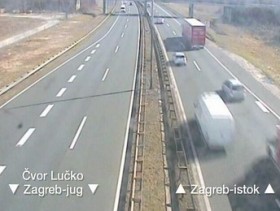Webcam Lučko

Lučko
Show webcamWatch the Lučko toll gate and its surroundings with an ONLINE webcam. The webcam monitors the current state of road traffic at the Lučko toll gate in Croatia.
Lučko, which is known for the Zagreb-Lučko intersection between the A1 and A3 highways, is located southwest of the center of Zagreb. Use the ENC electronic toll, which will save you an hour at the toll gate.
Take a look at the cameras capturing the Lučko toll gate, so you know if it's not worth it to sunbathe by the sea for a while, so you don't stand a hole here :-)
Zoom out to see other webcams around this camera. Lučko.
- Show webcams nearby
- Report broken
- View: 6937x
- A03112
Are you going to go to area Lučko? Such you are correctly with us :-). On the map, you will find webcams from the area Lučko and its surroundings. Thanks to online footage from the webcams of the area Lučko and its surroundings, you can set off at the right time and in sunny weather.
You are planning a holiday, a trip or a business trip in the next days and you are not sure what the weather will be like? Check out the weather forecast at www.yr.no - Croatia - Lučko and you will immediately know if to wait a few more days. :-)
Zoom out or zoom in on the map to see other webcams around your selected webcam. Click on the "bubble" to get information about the camera with the option to click on the detail.
Webcam Lučko on the map
Map showing webcams in Zagreb - Croatia. Do you know of any other cameras from the Croatian region of Zagreb? Add this webcam to us.
Croatia with the official name of the Republic of Croatia is located on the Balkan Peninsula on the shores of the Adriatic Sea and on many islands in the Adriatic Sea. Neighboring countries are Slovenia, Hungary, Serbia, Bosnia and Herzegovina and Montenegro. Croatia has a Mediterranean climate on the coast and a continental in the inland. Dry and hot summers are a typical feature of Croatia.
The capital and largest city of Croatia is Zagreb with the typical character of a large city of the former Habsburg monarchy. The city of Zagreb lies at the foot of the Medvednica Mountains, north of Croatia's longest river, the Sava. The individual regions of Croatia are administratively divided into 20 counties and the capital Zagreb with the same status.
The Croatian economy is dominated by tourism thanks to the tourist boom of the late 1990s. For many European countries, Croatia is one of the most popular holiday destinations. Tourists are mainly looking for the rugged Adriatic coast with many islands. The traditional place to stay by the sea is the Makarska Riviera and the Split area in Dalmatia. Furthermore, tourists often visit historic cities that are full of ancient monuments from Roman times and from the times of Venetian rule such as Dubrovnik, Split, Zadar, Sibenik, Trogir or Rijeka. In the inland is the most visited tourist destination Plitvice Lakes National Park.
Croatia is a land of sun, sea and relaxation, with more than 1,000 islands of various sizes from very small cliffs to islands with an area of over 400 km². Popular are the islands such as Krk, Cres, Hvar, Korcula and Rab, which thanks to its sandy beaches are among the most attractive islands in the area. On the Croatian islands you will find residential offers such as Robinson Crusoe type. This is accommodation in a quiet secluded place surrounded by wildlife, mostly in former fishing houses in remote parts of the islands. The Adriatic Sea also offers great opportunities for divers and yachtsmen. The most famous localities are Rogoznica, Primošten, Kvarner Bay, the islands of Jabuka, Vis, Rogoznica and Male Srakane, where the shipwreck is Baron Gautsch.
The Adriatic coast offers a plethora of private accommodation in apartments right by the sea or in the historic parts of picturesque towns such as Primosten. The Croatian Adriatic is an ideal summer destination for nudism fans. The most famous naturist beaches include: FORTUNA, ZELENA LAGUNA, POLARI - PUNTA EVA, VEŠTAR, MAŠKIN.
Croatia has a very rich cuisine. The basic ingredients are meat, fish, dairy products, vegetables and nuts. Meals often vary by region. The most famous include: Istrian Fiji with tubers, Lamb on a whisk, Brudet, Buzara, Grilled fish, Fiš paprikaš, Pršut, Cheese from the island of Pag and Štrukli. Croatia is also famous for its ice cream, which you should definitely taste on holiday.
Now to the Croatian monuments inscribed on the UNESCO list of monuments. The most important is the early Byzantine monument of the Eastern Mediterranean the Euphrasian Basilica in Poreč, Istria. Then the Cathedral of St. Jakov in Šibenik, which was built only of stone - limestone and Brač marble. The historic core of Trogir has been preserved in almost its original form from the 13th to the 18th century, where each house inside the walls has its own coat of arms and inscription. Furthermore, the city of Dubrovnik, which is surrounded by two kilometers long walls belonging to the largest defensive fortifications in Europe. The most important ancient building in all of Croatia is Diocletian's Palace in Split, built in the 4th century by Emperor Diocletian as his seat and at the same time a defensive fortress. A system of sixteen karst lakes Plitvice Lakes, which are arranged in steps of each other in a length of about 7 km and connected by 92 waterfalls falling from a height of 3-76 meters. Starigradsko polje on the island of Hvar, where it was preserved the division of land from 2500 years ago of Greek colonizers. The last inscription on the UNESCO list protects unique medieval tombstones (Stećci) from the 13th - 16th century.